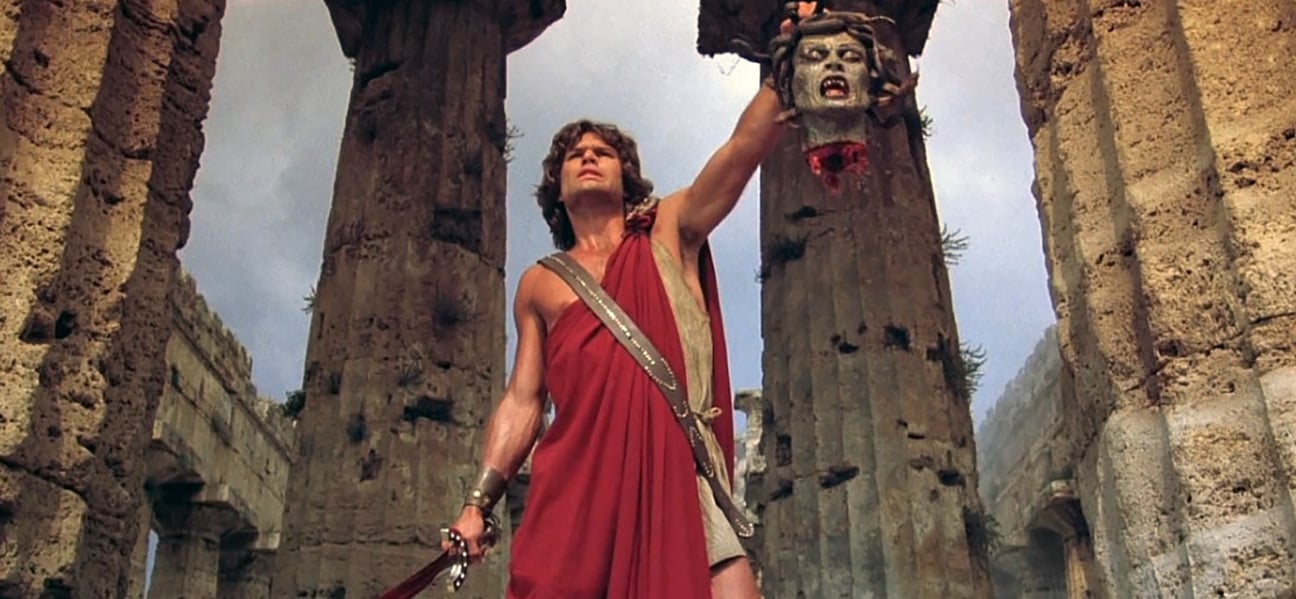
Behind the Scenes on Clash of the Titans
The Greek gods and goddesses of Mount Olympus mix it up with mere mortals in a lavish spectacle that features the stop-motion special effects of wizard Ray Harryhausen.

The Gods of ancient Greece were immortal. Endowed with supernatural powers, they breathed the rarified air of Mount Olympus, lived on ambrosia and nectar and were worshipped by the mere mortals who dwelt on the plains below and built temples to their honor.
Love and charity were not necessarily part of the lives of these super-beings — they frequently betrayed their God-like attributes. Benevolent, vengeful, contrary and bawdy, they quarreled and fought for power and pursued selfish aims. In fact, they were almost human.
To be Perseus, son of Zeus, could be considered an immaculate start to any man’s life, but not when your father’s philandering has upset a fistful of Gods as powerful as Hera, Athena, Thetis and Aphrodite. Perseus was to experience the vagaries of the humor and temper of these Gods.

Metro-Goldwyn-Mayer’s Clash of the Titans tells of Perseus’ battles to win the hand of the beautiful Andromeda. The Gods look down and help or hinder according to their whims, as Perseus, aided by Pegasus the winged horse, and Bubo, an owl of uncommon talent, overcomes the three Stygian witches with one eye between them; a monstrous two-headed wolf-dog, Dioskilos; Medusa the Gorgon; and, ultimately, the terrifying Kraken, a giant monster raised from its primeval home on the sea-bed to bring destruction.
Clash of the Titans is an exciting blend of live action and visual effects filmed in Dynarama, a process developed by the film’s co-producer and creator of special visual effects, Ray Harryhausen. The production has taken two years to complete, with principal photography occurring in four countries. One of the most spectacular films ever attempted, Clash of the Titans is the most ambitious project ever undertaken by producer Charles H. Schneer and his long-time collaborator Harryhausen.

Producer Charles H. Schneer entered the motion picture business in the publicity department of Columbia Pictures. During World War II, he made training and morale films at the Signal Corps Photographic Center in Long Island, N.Y., and in 1946 joined Universal Pictures as a producer. He was associate producer on many Columbia films for eight years and in 1956 became President of Morningside Productions, Inc. For this company he was responsible for Battle of the Coral Sea, Hellcats of the Navy and The Seventh Voyage of Sinbad. In 1960 he produced The Three Worlds of Gulliver and then formed his own production company. Since then, Schneer has made Mysterious Island, Jason and the Argonauts, Half a Sixpence, Land Raiders, The Executioner, The Golden Voyage of Sinbad and Sinbad and the Eye of the Tiger.
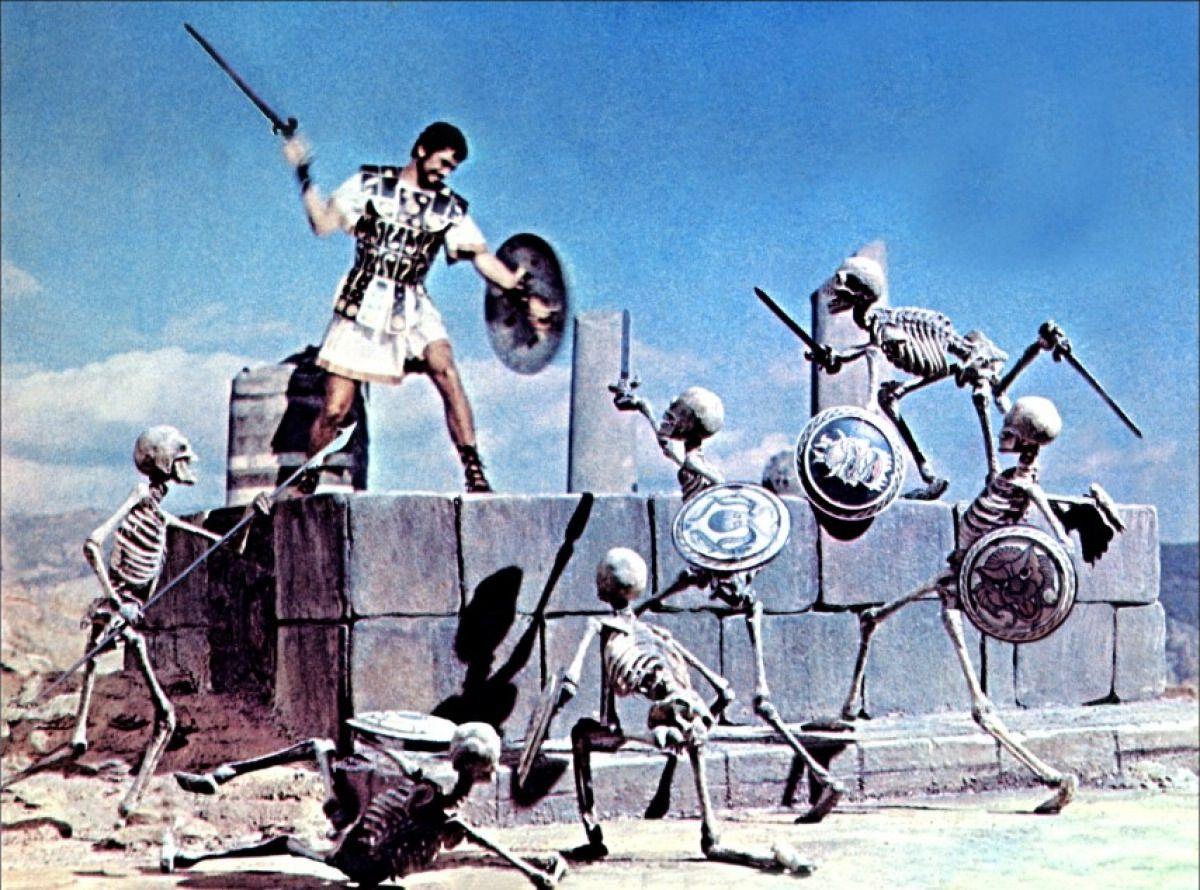
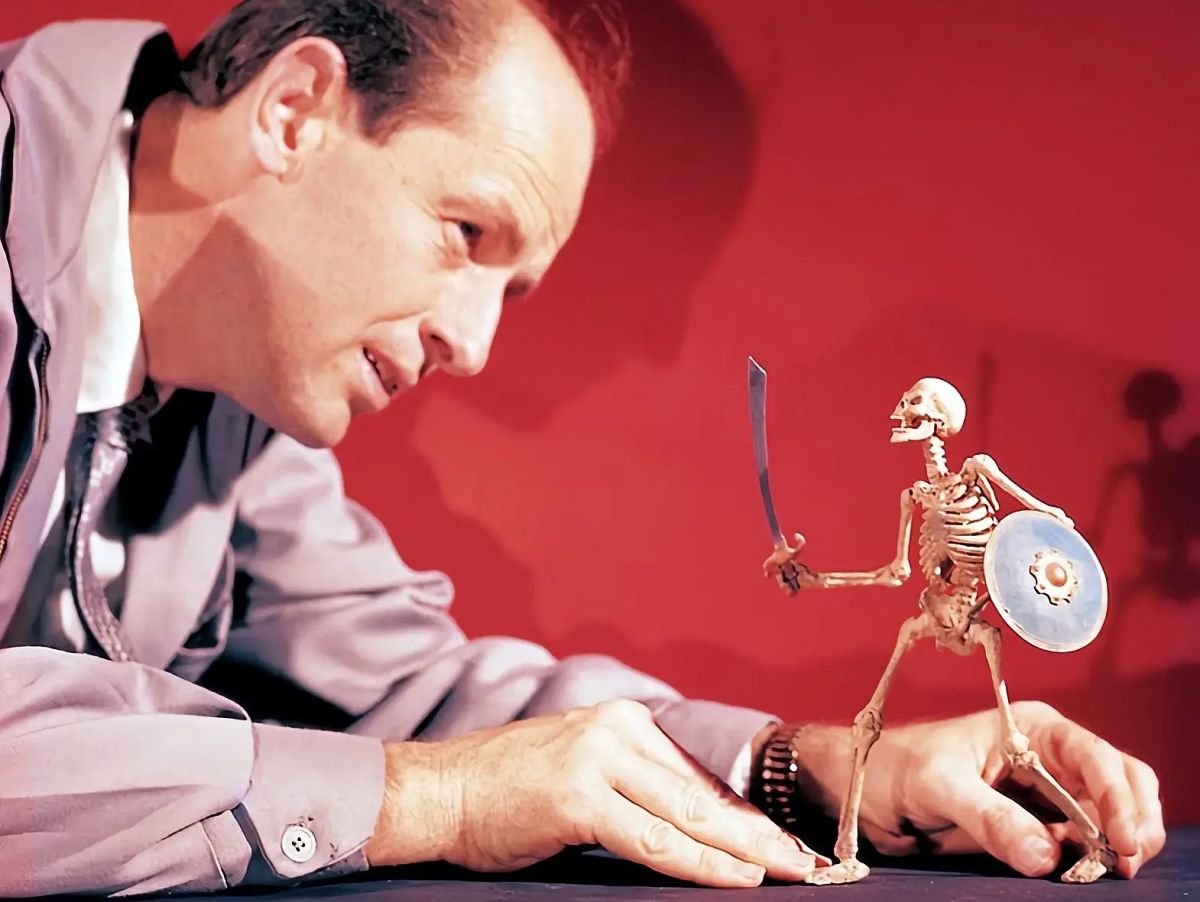
Ray Harryhausen is a co-producer and creator of special visual effects and his reputation stands high. In the more than 40 years he has spent animating three-dimensional screen fantasies, the name Harryhausen has become something of a cult. Born in Southern California, he attended City College in Los Angeles and studied dramatics, photography and sculpture. In 1933 he saw the first film of King Kong and says, “I haven’t been the same since.”
Early experiments in 16mm won him his first job, with George Pal’s animated Puppetoons. He served with the Army Signal Corps during World War II and in 1946 worked on his first feature, Mighty Joe Young, as head animator and assistant to Willis O’Brien. In 1953, Harryhausen was introduced to Charles Schneer. Together, they made It Came From Beneath the Sea and began a partnership which has endured through the years with increasing success on films such as The Seventh Voyage of Sinbad, Jason and the Argonauts, The Golden Voyage of Sinbad and Sinbad and the Eye of the Tiger.
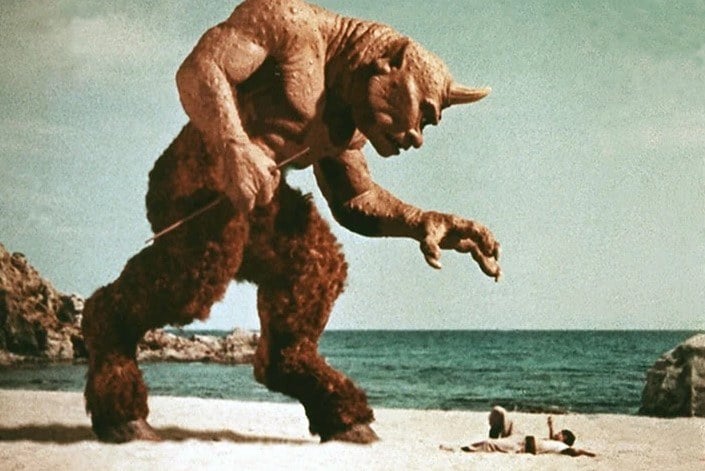
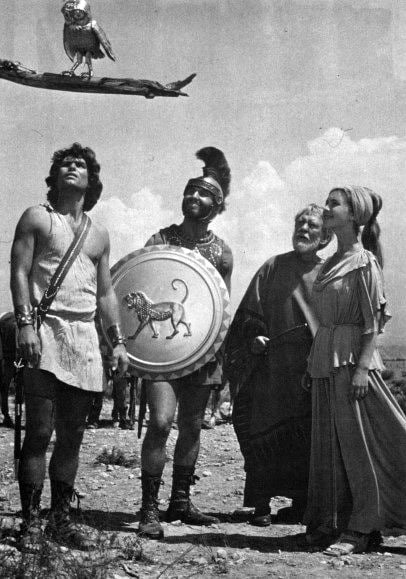
of golden metal by the blacksmith Hephaestus, Bubo, in the film, was radio-controlled in scenes where the actors are handling him. His wings flap, his head revolves, his eyes spin
and his mouth opens. At other times, a stop-motion model was used.
Director Desmond Davis was born in London. He began his career in films as a clapper boy and during World War II served with the Army Film Unit. As a camera operator, his credits include A Taste of Honey, Freud, Loneliness of the Long Distance Runner, and Tom Jones. In 1962 he directed Girl With Green Eyes, which won the David O. Selznick Award as Best Film at the San Francisco Film Festival. Davis’ other films include I Was Happy Here, The Uncle, Smashing TIme, and A Nice Girl Like Me. His three-part film for television, Eustace and Hilda, won the Golden Nymph for Best Direction at the Monte Carlo International Television Festival of 1978 and his production of Shakespeare’s Measure for Measure was screened recently in Great Britain and the US.
Beverly Cross, who wrote the original screenplay, is co-adaptor of the highly successful Boeing-Boeing and the current West End hit, Happy Birthday. Mr. Cross is married to actress Maggie Smith, who stars in the film.
The various mortals and immortals in Clash of the Titans are portrayed by a roster of distinguished international stars, also including Laurence Olivier, Claire Bloom, Ursula Andress, Burgess Meredith, Sian Phillips, Flora Robson, Harry Hamlin (as Perseus) and Judi Bowker.
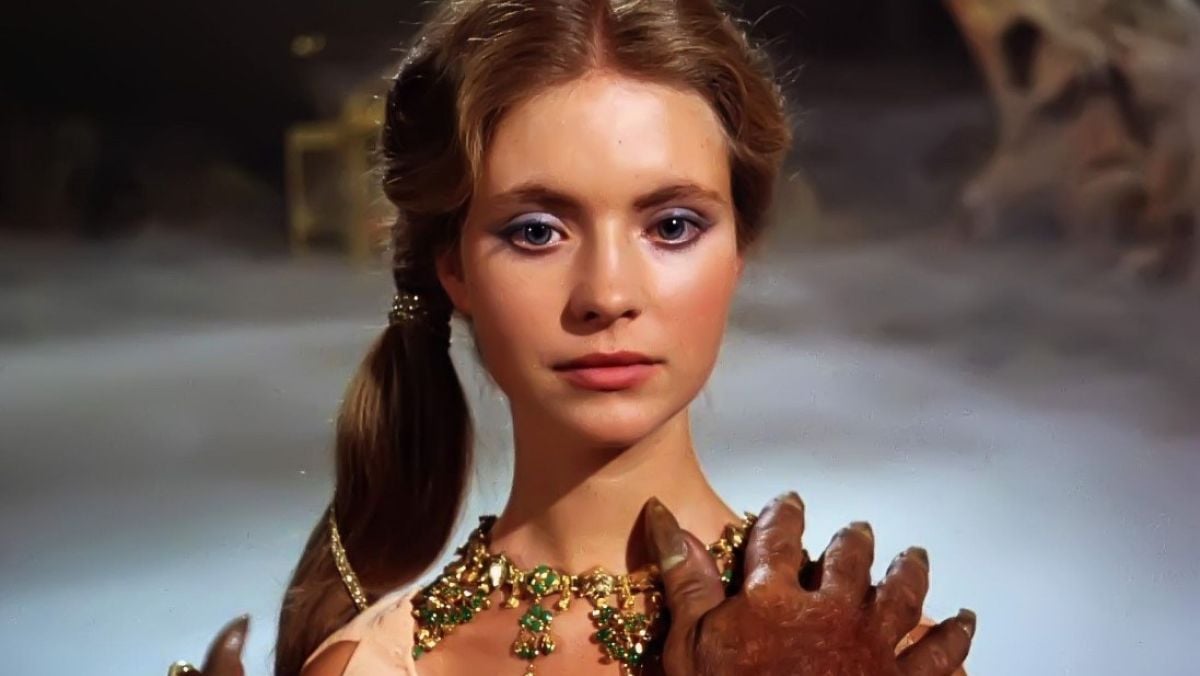
Ray Harryhausen is the acknowledged interpreter of stop-motion filming and creator of the propess known as Dynarama. Clash of the Titans is his 16th film using this technique. He has mastered the intricacies and frustrations of this form of filmmaking, yet finds the wonders of the computerized stopwatch too complex to grasp.
MGM’s Clash of the Titans is an excursion into Greek mythology based on the legend of Perseus and Andromeda. “We’ve gone into mythology before,” says Harryhausen, “with Jason and the Argonauts, and we always wanted to make a sequel. Mythology is the ideal subject for my form of cinema, but Clash of the Titans is more complicated than other films. We have a greater variety of monsters and creatures, locations spanning four countries and the technical part is more complicated. We have intimate scenes between the actors and a character called Calibos and they have to act and react accordingly as in normal dramatic situations. Calibos is part man, part creature and he is Dynamated in later sections of the film. It’s the first time we’ve done something as intricately woven as this."

Harryhausen has made dinosaurs walk the earth, horses fly, statues come to life, apes play chess, skeletons fight and Kali come to life, to the delight of cinema audiences the world over. He calls his work “kinetic sculpture” — a method of stop-motion filmmaking that has made him an outstanding, if not a cult, figure in the world of the cinema.
His world is peopled by creatures mythical, monstrous and magical. From his research and his imagination he pulls out a wealth of ingenious characters for every movie he makes.
In past films Ray’s creations have included a bridge-devouring octopus, dinosaurs, pterodactyls, sword-fighting skeletons, chess-playing baboons, and a host of other appealing, or possibly appalling, creatures. This talent for originating the fascinating, if sometimes slightly frightening, has not been checked in MGM’s Clash of the Titans. Ray Harryhausen has conscripted a host of the weird and wonderful.
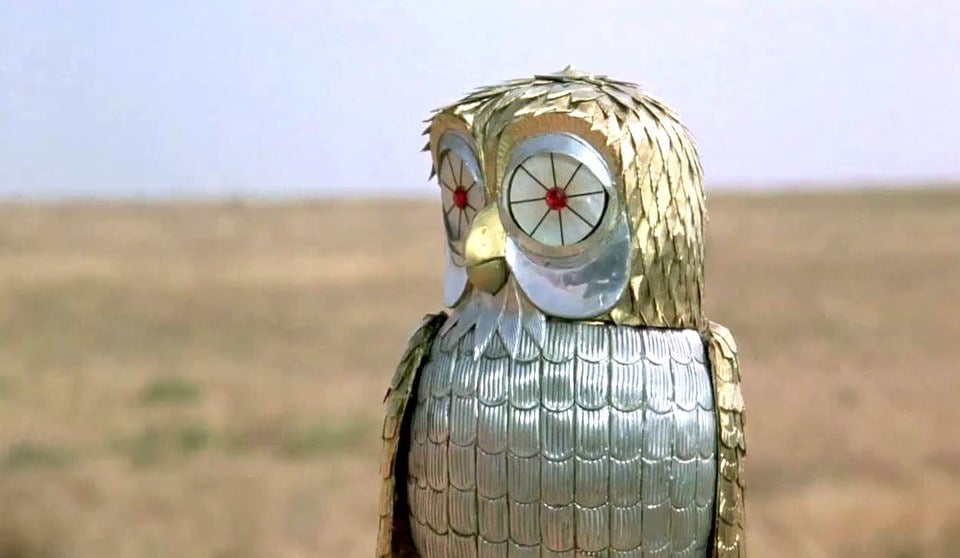
There is the magical Bubo, forged by the blacksmith Hephaestus at Athena’s command. Fashioned from golden metal, Bubo has a talent beyond the ordinary. He leads Perseus to the lair of the Stygian witches and when Perseus ultimately stands against the monstrous Kraken it is Bubo who saves the day. The owl is sacred to Athena and was thought by ancient man to be an animal of magic and superstition. A symbol of gloom and death, the owl was also revered as the possessor of great wisdom.
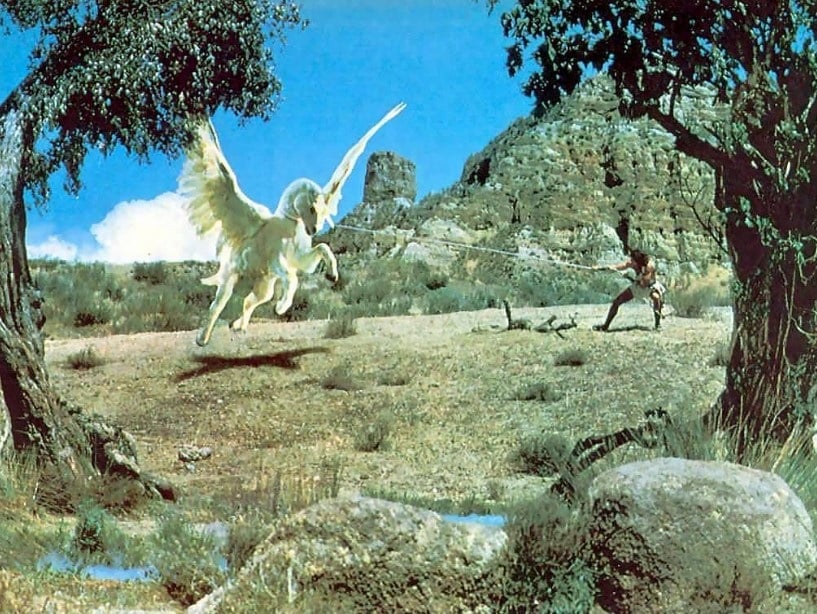
Pegasus the flying horse carried Perseus into battle against the Kraken. The pure white horse with wings to lift him through the skies is captured and tamed by Perseus at the Wells of the Moon. For his loyalty, Pegasus was rewarded by Zeus with a permanent place in the heavens where he lives among the constellations and carries the great god’s thunderbolts.
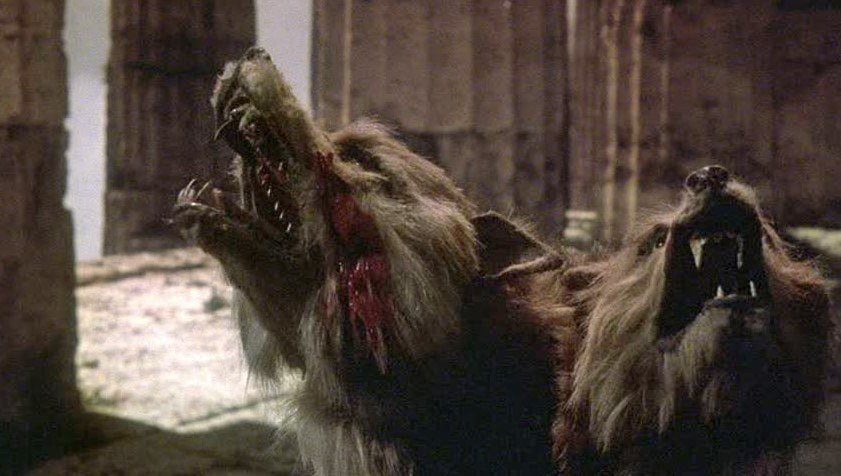
Dioskilos is not so appealing. A giant, ferocious wolf-dog with two heads, Dioskilos guards the entrance to Medusa’s sanctuary. In a terrifying fight, Perseus with Aphrodite’s sword severs one of the heads but the dog keeps attacking until with one lunge Perseus drives his sword through the body of Dioskilos.
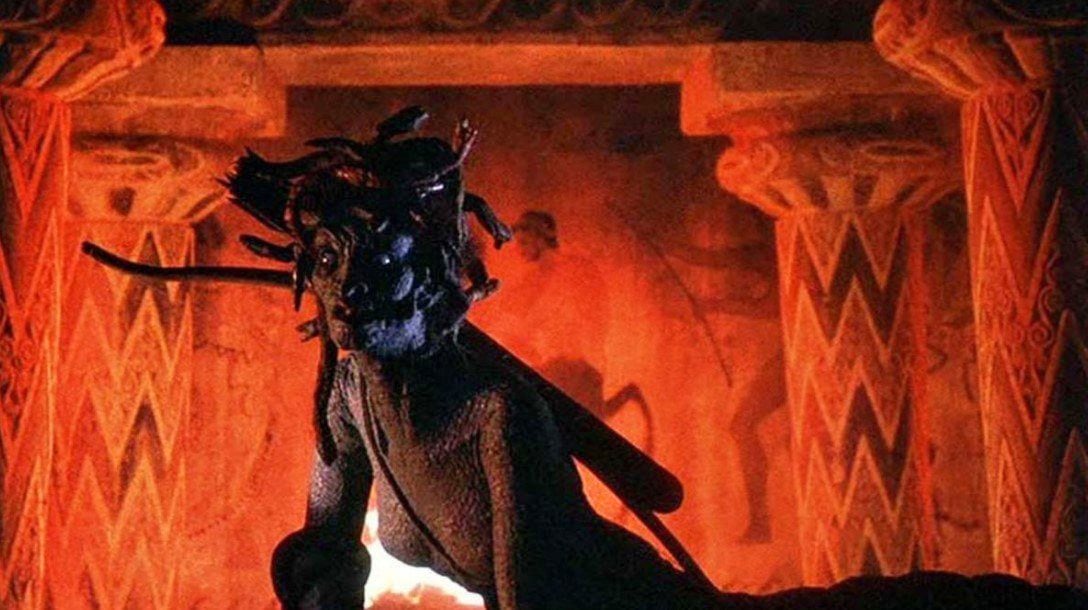
The Medusa was once a beautiful young girl seduced by Poseidon in the shape of a horse, some say a bird. Unfortunately, the sea-god chose a temple dedicated to Athena as the setting for his seduction. The goddess was enraged, feeling this to be a slight to her dignity and in revenge turned Medusa’s hair into snakes. So ugly was Medusa that one glance at her ravaged face could turn a man to stone.
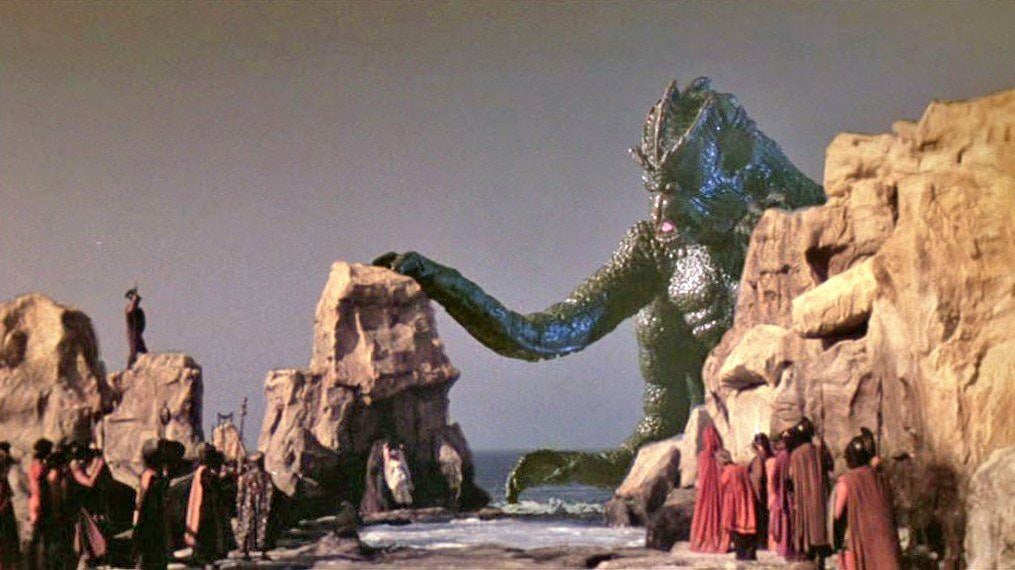
The Kraken is a giant sea-monster, the mutant child born of the union of one of the mighty Titans and a prehistoric reptile. Released from its ancient home on the sea-bed to avenge the pride of Cassiopeia, the Kraken rises in an explosion of churning sea to take Andromeda as sacrifice before being sent to a lasting death at the hand of Perseus.
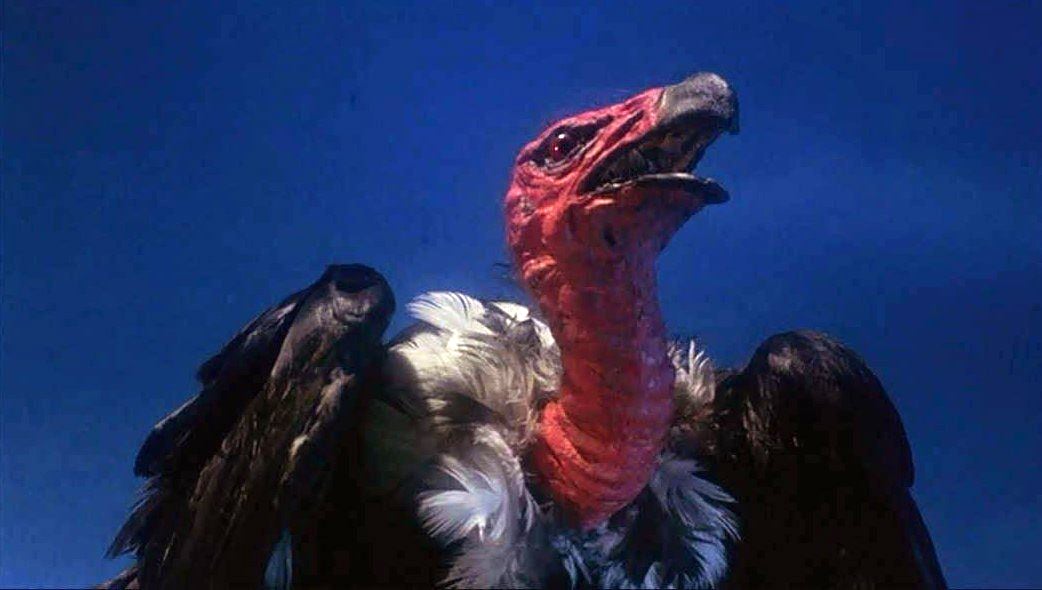
Calibos was once a golden, handsome youth but is now an odious, satanic, mutation, partly human, partly satyr. Cursed by Zeus, Calibos, with one cloven hoof, reptilian tail, clawed hands and goat-horned head lives in a foul, stinking swamp crawling with corrupt and awful creatures. Desirous of Andromeda’s love, Calibos has at his command a giant vulture, a rapacious bird of prey who carries off Andromeda in a gilded cage.
Charon is the boatman who ferries people to the Isle of the Dead, hooded and cloaked in black. As Perseus comes close to pay the boatman with slver coins he sees the outstretched hand of a skeleton and beneath the fustian cowl a grinning sightless skull.
Giant Scorpions who spring from the blood of the severed gorgon’s head can kill a man with one venomous sting.
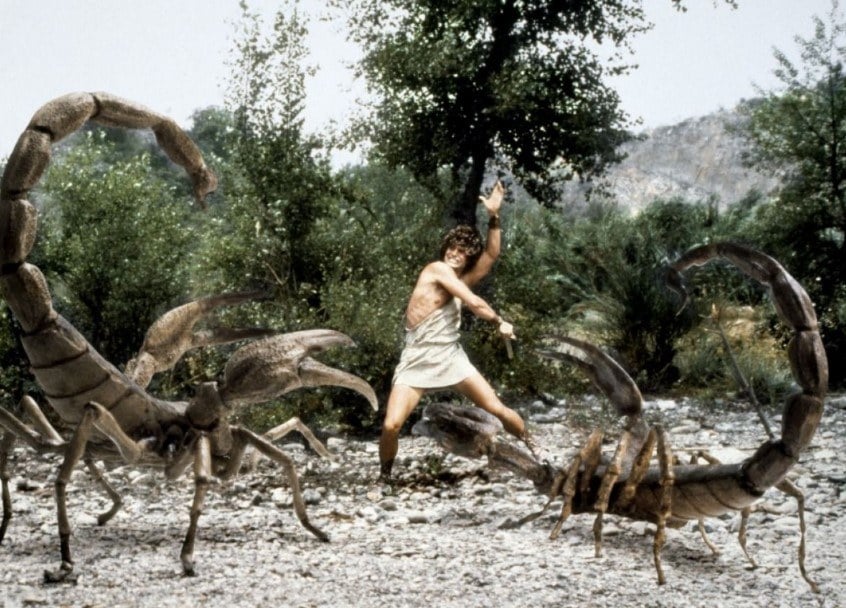
These creatures are all visualized and produced by Harryhausen from his imagination and the stories of mythology. The Greeks had a well-developed sense of the extraordinary as their legends show and it is not always necessary to stretch the mind too far to create something out of the ordinary. “I have a little storehouse of animals in my head,” says Harryhousen, “but the story dictates what creatures you use and often stimulates a whole new way of thinking. You cannot really say you have a stock library of monsters because it does depend on the story and the concept. Of course, the more pictures of this type you make the smaller the store becomes.”
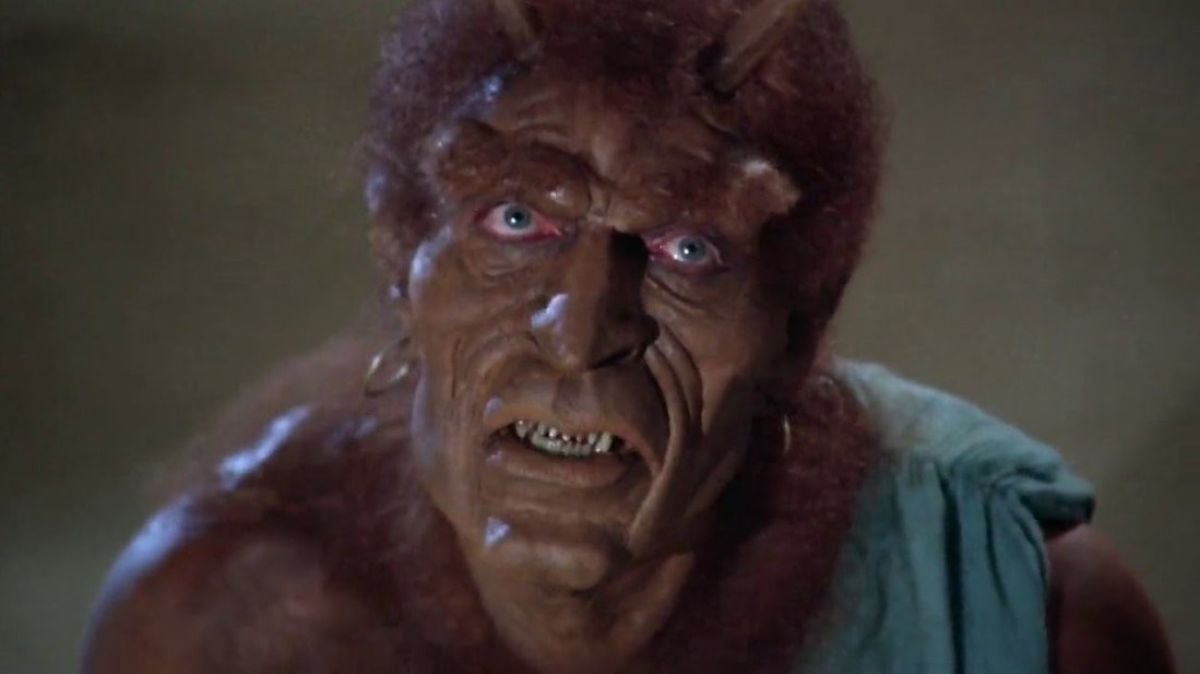
Clash of the Titans was filmed on location on some of Europe’s most historic sites. Fought over by the Etruscans, the Romans, the Greeks, and the Saracens, the Italian soil is rich in history. In southern Italy the temples of Paestum, which date back to the middle of the 7th Century B.C., the deserted beaches of Palinuro, and the ancient amphitheatre at Ostia Antica became once more the home and playground of the Gods.

The caves and rocky shores of Malta and the spectacular barren scenery of Gaudix and Antequerra in Spain also recreated scenes of epic legend. Mount Olympus, the interior of the Temple of Thetis, and the palace of Cassiopeia were constructed at Pinewood Studios, London, utilizing the largest sound stage in the world.
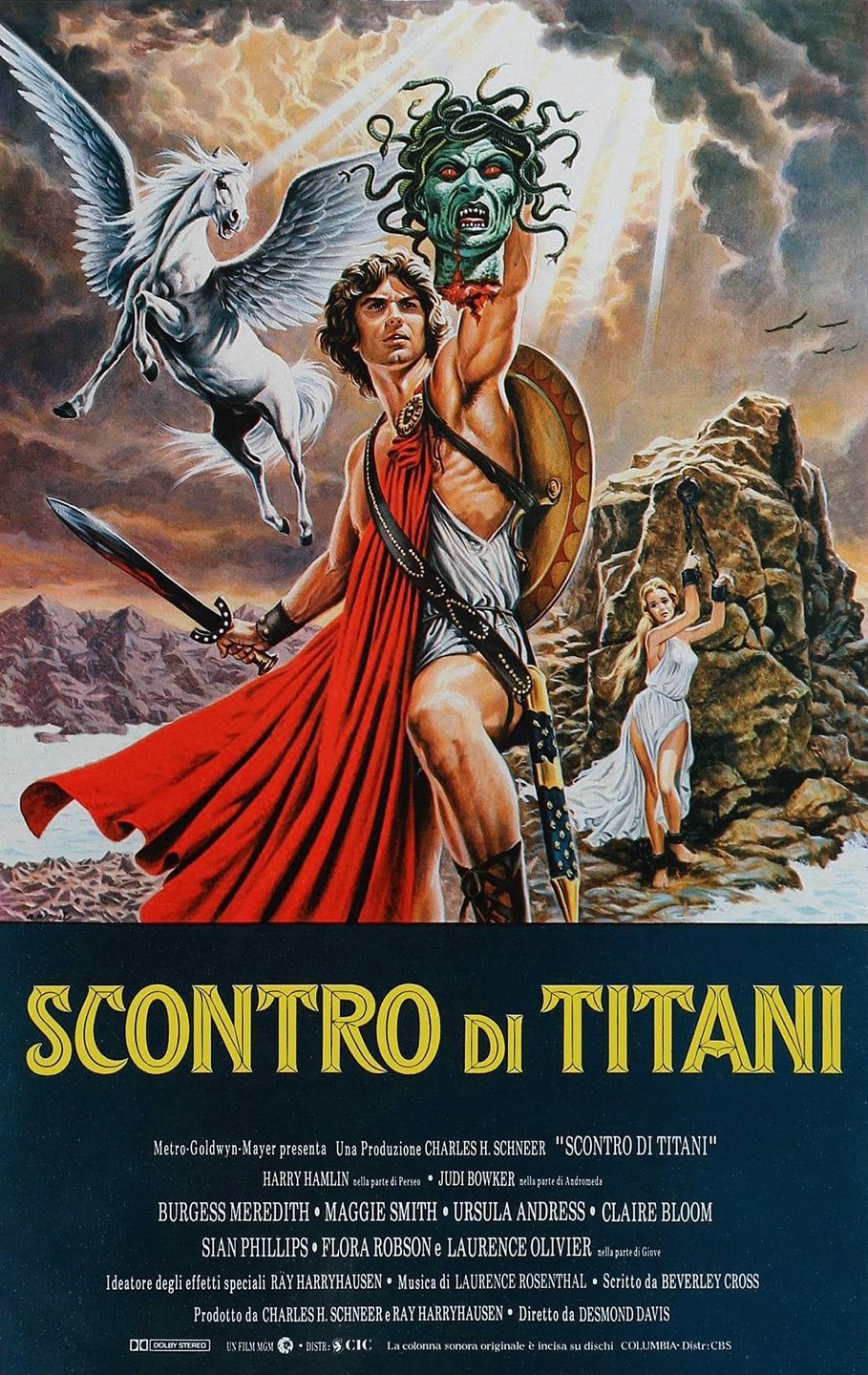
You’ll find our complete interview with Ray Harryhausen — discussing the making of Clash of the Titans, which would become his final feature-film project — here.






